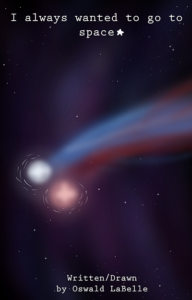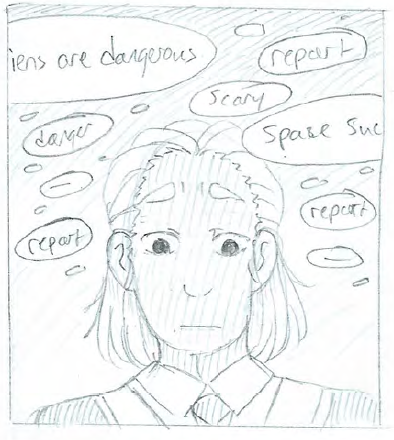By: Oz Labelle

The comic I’ve Always Wanted to Go to Space depicts a college-age man accidentally bringing home an alien who crashed at a nearby beach, and happened to save his life from another alien who crashed at the same spot and time.
I had originally tried to contain a more singular story into the mini-comic, simply ending the comic with the alien who saves the man flying away, in a super-hero/anti-hero-esc fashion, cops chasing behind them and everything. I also dabbled with the idea of making the comic more heroically inspired in general, but felt this didn’t match with the mystery and limitlessness the use of the alien concept provided. So, I ended with an 8-page mini comic that alludes to a continued series.
In this first segment we see the introduction of the man and alien and the start of his realization that the propaganda produced about aliens may not be all it’s cracked up to be. In a perfect world, I would have continued and drawn two or three sequel comics, probably shorter in length, depicting the man and alien in daily life, since they are now essentially stuck together (the man didn’t report the alien to his local Government office, so he is now a “criminal” for “harboring an illegal otherworldly being”). Names aren’t introduced for characters immediately, as they would be introduced gradually in the overarching concept of a series of comics. In the continuation of this comic, the man and alien gradually learning from each other about how each species lives, and how co-harmonious they are, despite the fact that propaganda labels all aliens as dangerous, aggressive, and violent.

This comic shows the introduction to the concept of challenging demonization with real experience, but I think seeing how two dissimilar identities and learn and grow from interacting shows the real lesson that propaganda and demonization can keep us from meaningful interactions and relationships, and is a tool used to spread fear, not necessarily the truth. Another key aspect with the sequel comics would be introducing other aliens and humans alike, with or without relationships, all hiding from the Government similarly to how the man and his alien friend are. Showing that there are more than singular exceptions from demonization is another important message, since I’ve personally heard many people use the “you’re the one exception” reasoning to try and defend demonization and propaganda.
A vaguely-government agent character is also introduced at the end, and would appear at random in sequel comics, causing issue in trying to capture the alien or persuade the man to convince the alien to willingly leave the planet. She and her fellow agents would be an introduction of how the Government is using propaganda, which is really to cover up with own involvement with an intergalactic war between different alien races, and a larger back-story. Long story short, a specific alien race attacked Earth for resources, resulting in a global war and millions of deaths. There was aid from other alien races that different Governments around the world had befriended, but the technicalities hadn’t been common knowledge, so general populations were reacting aggressively, demanding protection from “aliens” in general.
Several Governments of the world got together and realized that the risk of causing more violence was high, especially if they tried to explain that certain alien races were involved positively, and have been for years. The collection of Governments decided to cover the whole thing up, launching an anti-alien propaganda campaign in order to appease the remaining populations of the world and provide a cover image to hide their continued involvement in universal affairs. Government offices don’t do anything to aliens that are reported except send them home with an apology, free of charge, unless they are guilty of some level of Galatic crime. Space explorations are publically seen as non-existent aside from space station trips. In actuality there’s a secret space organization hidden by the Governments of the world.
The setting, on the surface, is similar to our society, but once you get into the technicalities is pretty fantastical, which I purposefully designed as a way to give me more artistic freedom. I don’t have to keep strictly to our reality, which means I can design this world similarly enough to allow for association between readers but loosely enough where it’s not portraying a very specific place with the guise of realism and replication. It’s similar to how Steven Universe has a world built similarly to ours, with key differences.
Another key aspect of the setting is the perpetuation of propaganda by a large majority of society. On the train, the man hears the propaganda messages repeated in murmurs over and over again, which later repeat in his head when he actually encounters the aliens. Demonization tries to target an audience, not just a specific individual, when promoting it’s message, and is most successful when convincing an audience, since that audience then holds their own community to the standards of the propaganda. I wanted to capture this individual and group appeal in my comic as a technique of demonization and propaganda, but show that just because a group of people around you believes something doesn’t mean you have to. Just because the man hears the propaganda messages repeated and upheld, doesn’t mean he has to believe it at face value, and he can critically analyze it later in comparison to his own experience, as well as meet others who have done the same (in the overarching continuation of the comic).
I designed the main lead as a tall, reasonably built college-age man, in hopes of having a character that could be widely relatable (and in hopes I could break down some silly gender rules while I’m at it, because I know what I’m about). The alien is male-presenting but doesn’t have a confirmed gender, because I designed most aliens to not really understand or subscribe to genders unless there is good reason or that individual alien of that individual species makes said choice. Both the main alien, and counter alien that fights them in their introduction, are fish-based, because I wanted the aliens to be flexible, complex characters, and when I thought flexible I thought water, which led to fish aliens. Also I love fish, so bias observed there. Metaphorically, I feel fish were a good choice, since there are numberous species and subspecies of fish that go generally unnoticed under the umbrella term of “fish,” similar to how the aliens feel. Though, the aliens feel the discrimination on an understandably larger scale.
I wanted the aliens to be similar enough to humans but also different enough to be distinctly not human. This way they were recognizable as aliens, while showing the ridiculous lengths alien propaganda went to in order to portray aliens as scary. Demonization often heightens physical attributes to create a pattern; so all the propaganda showed aliens with classic bulbous heads, big black eyes, a sharp-ridged back, and clawed hands. These features make aliens seem grotesque and scary, similar to how real propaganda makes minority groups grotesque or unappealing. The real aliens, in comparison, while different, aren’t ugly. The main alien isn’t menacing at all, while counter alien is, but not necessarily in appearance so much as attitude.
I introduced the aliens as fighting each other namely to differentiate them from one another, and show the diversity in alien species, another key point in fighting demonization. “Aliens” is an umbrella term used to describe many individuals, but is associating a large group of diverse people inaccurately under stereotypes. The aliens in my comic are similarly grouped; they don’t look alike, they don’t act similar, and they have very different goals from one another. The two aliens aren’t even of the same species but are grouped under the evil and antagonizing imagery used in alien propaganda. This dichotomy is meant to point out how falsely the umbrella terms used in propaganda group individuals, and introduces the competitive ideology that just because someone is one term, for example “alien,” doesn’t mean they are the same as “aliens” in media, or other “aliens.” Propaganda will try to water down diverse groups of individuals in order to promote a message, and I wanted to highlight this technique in my comic.
Overall, I wanted to show how demonization can limit communities, water them down to overgeneralized groups of individuals, and portray them consistently with specifically chosen traits in order to promote a message of fear and hatred. By using aliens and a more fantastical setting, I wanted to create a world and story that was both relatable but not too closely tied to our world that it would create discrepancies that distract from the story. This comic subtly shows how demonization can set up false understandings of other people, and shows that experiencing the lives of other people and attempting to understand one another is the best way to combat misinformation and learn the truth about others. To best understand the world around you, you have to ask questions, even if that means challenging what you see in front of you with what society teaches you, or vice versa. The themes are clear, but not too explicit to make the educational intent of the comic shallow, or to make the comic seem as if it is preaching to a specific group of people.